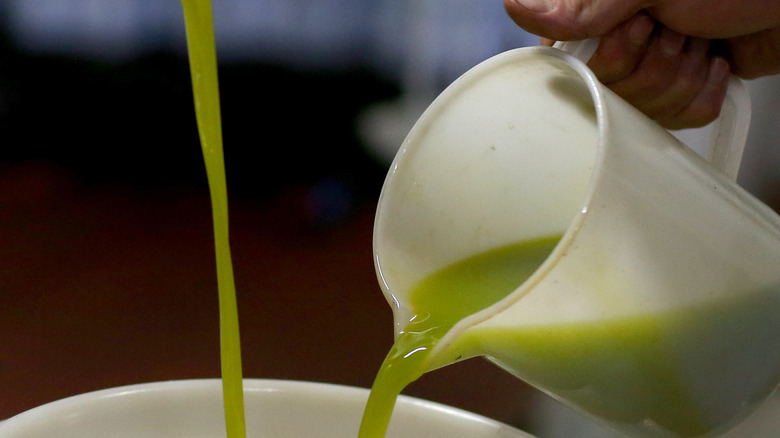Spanish Olive Oil Vs Italian Olive Oil: What's The Difference?
To ask whether Spanish or Italian olive oil is better than its counterpart is the wrong question. Both can be of exceptional quality and are a welcome (and often necessary) addition to countless recipes. To ask whether Italian and Spanish olive oils are the same, however, is perfectly acceptable, and the answer is no, they are not. The primary difference between Spanish and Italian olive oil, aside from the obvious difference in their place of origin, is in their flavor. According to L&P Global: "A Spanish olive oil has a nutty and rich fruity taste while Italian olive oils have a hint of herbal tang and have a grassy flavor."
There is a distinct difference in flavor profile, to be clear, with Italian olive oil readily lending itself to use in many cooked dishes from pastas to seafoods to baked goods, while Spanish olive oils are often the better choice with foods that are not cooked, such as tossed over salads or served as a dip or drizzle for breads. We'll look at a few specific use cases when it makes sense to choose either Spanish olive oil or Italian olive oil later, but for now suffice it to say that provenance and flavor are the major differences between these two globally popular olive oils, both of which have been enjoyed for millennia.
A brief history of olive oil
While now produced in myriad parts of the globe, from Italy, Spain, Greece, and other Mediterranean nations to several African nations to Australia to American states including California, Texas, Hawaii, and others, traditionally olive oil comes from Eastern Mediterranean lands. According to Olive Oil Source, olive trees were actively being spread from their native territory at the eastern end of the Mediterranean Sea as far back as 6,000 years ago. Olives were being grown and olive oil produced on the Grecian island of Crete as far back as 3,000 BCE, and by 2,000 BCE olives were being placed in Egyptian tombs.
By the time the Roman Republic began its spread up and down the Italian peninsula, starting near the end of the 6th BCE and accelerating in coming decades, olive trees were common throughout much of the land and olive oil was becoming a dietary staple. According to Spanish Food: "Olive trees were not unknown in the Iberian Peninsula, but olives were not greatly cultivated until the Romans invaded Hispania in 212 B.C., led by Publius Cornelius Scipio Africanus."
The Roman taste for olive oil saw a surge in production of olive oil in the territory now known as Spain, where many olive trees today are well over 1,000 years old (via: CNN). These so-called millenary trees produce olives and, subsequently, an olive oil quite similar to that which would have been consumed in ancient and medieval times.
How Italian olive oil is made and how it tastes
Italian olive oil starts its life as olives harvested just before ripeness, according to Walks of Italy. Then the olives are ground into a paste, a process that actually requires a careful, delicate touch as they must be ground up without their pits being crushed. This paste is then spread out on presses — traditionally made from stones, but now usually steel machinery — and the liquid is squeezed from the olive paste. The oil thus produced (and then separated from the water also present via centrifugal force) is the first pressed and is of the highest quality; second pressing is when heated water is added back to the pressed olive pulp which is then squeezed a second time.
As noted earlier, most Italian olive oils are tangy and grassy in taste, with light bitterness, an herbal undertone, and an overall delightful complexity that accentuates all sorts of foods. The issue with Italian olive oil is that much oil produced under that title is hardly Italian at all. Walks of Italy reports that "Olive oil can be sent to Italy, blended with even a minor percentage of Italian oil, and then sold as a local or 'Italian' product, even with 'produced in Italy' on the label." To be sure you are getting 100 percent Italian olive oil, look for one that is certified as Protected Designation of Origin, or PDO. (And note that is DOP, for "Denominazione di Origine Protetta," in Italian.)
How Spanish olive oil is made and how it tastes
Currently, Spain is credited with the production of nearly half of all the olive oil produced on the planet, making it the largest olive oil producer and exporter on earth, according to Foods and Wines from Spain. (Italy produces about 20 percent of the world's olive oil, according to Live Strong.) Spanish olive oil, like its Italian counterpart, is usually produced using olives picked (or rather shaken from trees mechanically) that are just shy of ripeness. According to Spanish Abores, pressing is rare in the Spanish olive oil industry these days, with most olive oil from Spain collected from olives that are milled into a pulp and then spun through a centrifuge, and always at temperatures below 86 degrees Fahrenheit.
As stated, Spanish olive oil tastes sweeter and nuttier than Italian olive oil. It can also have a fruity character to the flavor as well as a bit of peppery taste, and it is usually less herbal than Italian oil. That all noted, many regions of Spain produce olive oils and the flavor profile can be markedly different from groves in, say, Andalucía, as compared to olives raised father north in Catalonia. Also note that unfiltered, hazy Spanish olive oil can taste much different than refined and filtered oils.
The differences between Spanish and Italian olive oils
Spanish and Italian olive oils have notably different tastes, with the former more nutty, fruity, and sweeter, while the latter tend to be more herbal, grassy, and with a mild bitterness. Beyond their flavor, there is usually a distinct difference in the appearance of oils from the two regions as well. Up and down much of the peninsula, Italy's climate tends to be relatively similar all year long, and this leads to olives that produce a green-tinted oil.
The Spanish climate is excellent for growing olives, but unlike Italy, much of Spain does experience more pronounced seasonal changes, with hot summers and cold winters. This change in the seasons is why Spanish olive oil is usually much yellower in color than Italian oils, according to Live Strong.
It's important to keep in mind that much of the oil sold as Italian is in fact actually primarily from Spain, given the loose labeling laws noted before. So if you get a yellow, nutty olive oil that is marketed as Italian, know it's quite likely primarily from Italy's peninsular neighbor to the west. (In fact, up to half of all "Italian" olive oil may hardly be Italian, according to Centra Foods.)
All that said, when push comes to shove, you can use these olive oils interchangeably in many dishes. If you have genuine Italian olive oil and you're preparing an Italian dish, use it, and the same is true for Spanish oils and cooking. But don't leave an olive oil out of a recipe because it's the wrong country of origin — that would be a much larger mistake.
The health benefits of olive oil transcend borders
No matter what kind of olive oil you are using, be it Italian, Spanish, Greek, Californian, Australian, Tunisian, and so on, if it is a pure olive oil it is a healthy foodstuff you can and should feel good about using. According to Healthline, olive oil is loaded with healthy monounsaturated fat, which can reduce inflammation and may help your body fight cancer, it is loaded with antioxidants, it can reduce the risk for strokes and help prevent heart disease, and it may help stave off Type II Diabetes and Alzheimers.
According to L&P Global: "One of the components that make an olive oil healthy is Cycloartenol. Cycloartenol is a known steroid alcohol or sterol that helps reduce the amount of cholesterol that is moving through your body... [and] Italian virgin oil has a higher level of cycloartenol compared to Spanish virgin olive oil." So in that specific regard, pure, genuine Italian olive oil may have a slight leg up on Spanish olive oil in terms of health benefits.
Overall, though, olive oil is simply a healthy (and delicious) foodstuff that belongs in every diet and that is a major reason why the vaunted Mediterranean diet has proven to be such a benefit to the health of so many (via: Mayo Clinic).





